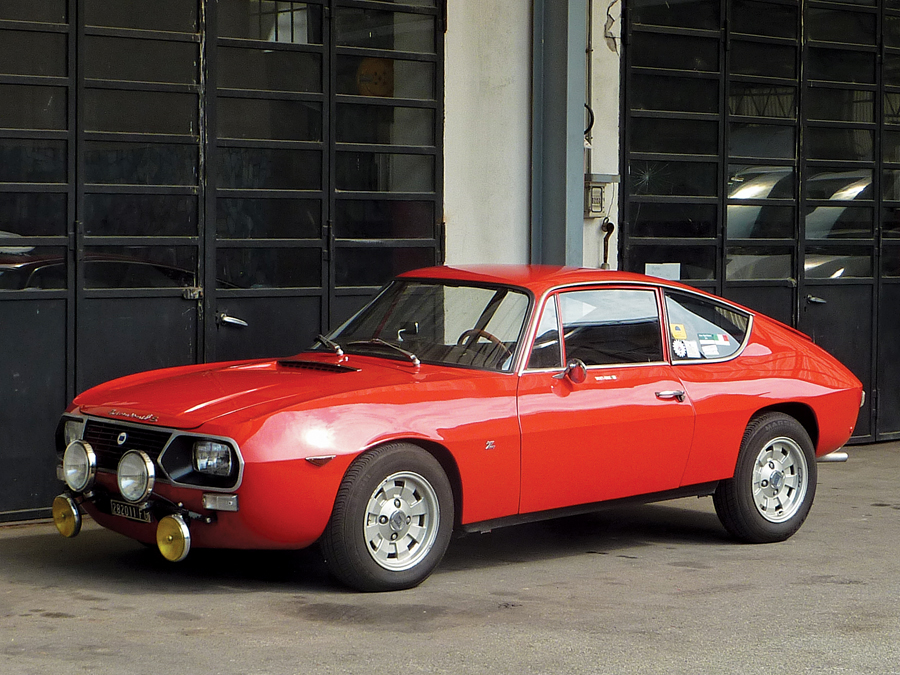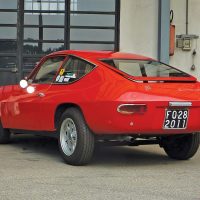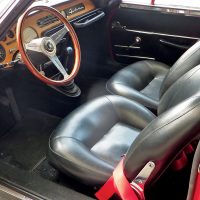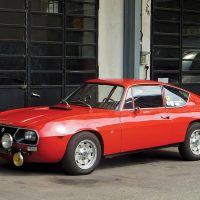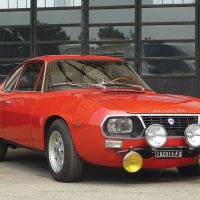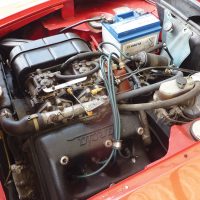Lancia commissioned Zagato to produce a more aerodynamic and sportier version of the Fulvia that also could be used in hillclimbs and track events. This model, designed by Ercole Spada, was technically advanced with its narrow-angle V4 tilted to lower the center of gravity. With 4,000 units produced, it is one of Zagato´s biggest successes.
The car on offer is a Series 2, which was fitted with a steel body and an upgraded 5-speed gearbox instead of the first series’ 4-speed gearbox. It has been nicely restored and has been used mainly for regularity and classic-car events in the Emilia-Romagna province of Italy.
SCM Analysis
Detailing
| Vehicle: | 1972 Lancia Fulvia 1.3S Zagato |
| Years Produced: | 1970–72 |
| Number Produced: | 3,400 (all Series 2) |
| Original List Price: | $6,300 |
| SCM Valuation: | Median to date, $35,700; high sale, $49,500 |
| Tune Up Cost: | $375 |
| Chassis Number Location: | Plate riveted to inside left side of engine compartment, stamped in firewall |
| Engine Number Location: | Lower right side of block |
| Club Info: | American Lancia Club |
| Website: | http://www.americanlanciaclub.com |
| Alternatives: | 1972 Alfa Romeo 1600 Junior Z, 1972 MGB GT, 1972 Chevrolet Camaro RS, 1972 BMW 2002 tii |
| Investment Grade: | B |
This car, Lot 174, sold for $37,755 (€34,568, €1=$1.09) including buyer’s premium, at Artcurial’s Paris, FRA, auction on October 30, 2016.
The confluence of the great names of Lancia and Zagato almost certainly guarantees an interesting car. And almost all cars that find favor in the marketplace have some specific attributes of interest setting them apart from the mundane. Of course, rules don’t always work out the way they should, but they often provide a window into reasons for appreciation (or the lack thereof) — and sometimes a hint of potential price growth.
I need spend no time here extolling the virtues of Lancia, but I will take a very brief detour into the subject of what constitutes a “real” Lancia. Certain hair-shirt marque purists will say that no car bearing the badge built after the 1969 Fiat takeover can be considered to be worthy of the distinguished lineage, due to the effects of Fiat cost-cutting in production and later development and design.
The truly devoted draw the line in the sand at any car after the 1937 Aprilia, the last car Lancia founder Vincenzo Lancia oversaw before his death the same year.
Other, more open-minded Lancisti embrace cars up to and including the Gamma of 1976. They also find it impossible to disregard the all-conquering rally giants — the Ferrari-powered Stratos and wholly Fiat Group-conceived Delta Integrale, launched in 1973 and 1979 respectively.
On to our subject Fulvia
Lancia saw considerable competition success earlier with the Fulvia HF coupe, including the World Rally Championship in 1972, and it was not unexpected that the Zagato variant, the Sport, would extend the accomplishments.
The company never raced the Sport, leaving it to privateers to run — in distance events — the less-than-30 examples of the Sport Competizone. The best result for the Sport was an 11th overall and class win at the 1969 24 Hours of Daytona.
As was the case with the other Fulvia coupe models, the Sport was developed through many variations. Lancia changed their internal type number for changes they considered major. By their reference, there were five type designations for the Sport during its production run, but they are split rather confusingly only into Series 1 and Series 2.
These changes included two gearboxes, three engines, from 1.2 liters to 1.3 liters on the way to 1.6 liters — and a number of body changes. Opinions vary on which is the most desirable, but, as should be the case, the answer lies in your personal preferences. I am the former owner of an early 1.3-liter Sport, the eighth produced after the switch from all-alloy bodywork to steel with alloy hood, doors and spare-tire lid.
My Sport also had the 4-speed gearbox — and was an original U.S.-delivery car. I was the second registered owner, and I reveled in the solid build quality, vice-free handling (even with FWD), roomy interior and supremely comfortable Zagato bucket seats. The later cars of the Series 2, launched in 1970, lost many of the quirkier features of the Series 1, including the hood that was hinged on the right side and a spare tire behind a hatch on the rear fascia.
The Series 2 cars also were fitted with a 5-speed transmission, which, in my opinion, loses the almost-ideal gearing of the original while still not providing an overdrive top gear for highway driving. In any event, as stated earlier, it can all be down to personal preferences.
In regards to values, the earliest Series 1 alloy and steel and alloy cars have led the market, with the Series 2 1600 Sport — the fastest Fulvia built — following.
A car on the rise — but still reasonable
Looking at the values of the Fulvia Sport in the past five years, by any measure the cars have doubled. Despite that increase, they still remain very reasonably priced for a coachbuilt car. They are totally usable in today’s traffic, capable of turning heads and providing a very entertaining driving experience. As in the greater market, prices are ever more specific to individual examples. Our subject car did not sell at the top of the range — for reasons that were plain to see in the catalog photos and copy.
It appeared to be set up for casual event use. The bumpers were removed, extra driving lights fitted and a smaller-diameter, more-modern, wood-rim steering wheel installed. The rear bumpers were included in the sale, but there was no word on the front bumpers or the original steering wheel. The car seemed to be a well-presented driver, and as such, the price realized seems to be perfectly fair.
The new owner should be able to enjoy his Lancia to the fullest, improve and restore it to original specifications as desired when desired and likely experience good appreciation as well. It may be time to upgrade the Fulvia Sport from SCM Investment Grade C to a solid B. ♦
(Introductory description courtesy of Artcurial.)
